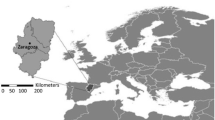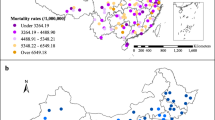Abstract
Heat waves associated with climate change are a significant future concern. Although deaths from heat disorders are a direct effect of heat wave incidences, only a few studies have addressed the causal factors between heat wave incidences and deaths from heat disorder. This study applies regression analysis to the time series data in order to deduce the causal factors that affect the number of deaths from heat disorders (NDHD) in Korea using observational dataset from 1994–2012. The duration of a heat wave and the age of the population are highly correlated with the magnitude of the NDHD. Based on this correlation we also analyze heat wave projections to the climate change scenarios produced using the Hadley Centre Global Environmental Model version 3 under the Representative Concentration Pathways (RCP 4.5 and RCP 8.5) and to the single aging population scenario till 2060. The magnitude of the NDHD is expected to elevate by approximately fivefold under the RCP4.5 and 7.2-fold under the RCP 8.5 scenarios compared to the current baseline value (≈23 people per summer). Of greater concern is that the steady death rate increase is expected to be intercepted by the more severe events in future compared to the present period. Under both RCP scenarios considered, the extreme cases are projected to eventuate around the 2050s with approximately 250 deaths. We find that in spite of the greenhouse gas policy proposed to meet reductions under the RCP 4.5 scenario; serious heat wave damage in terms of human mortality may still be unavoidable in Korea.









Similar content being viewed by others
Abbreviations
- AR:
-
Aging ratio
- ANN:
-
Artificial neural network
- Β:
-
Standardized coefficient
- BP:
-
Breusch-Pagan
- DHW:
-
Maximum duration of heat wave days
- DT:
-
Daily maximum temperature
- HadGEM3-RA:
-
Hadley Centre Global Environmental Model 3
- MES:
-
Mean Squared Error
- MK-PRISM:
-
Modified Korean-Parameter-elevation Regressions an Independent Slopes Model
- MSE:
-
Mean square error
- MT:
-
Mean of maximum temperature
- NDHD:
-
Number of deaths from heat disorders
- NHW:
-
Number of heat wave days
- p value:
-
Probability value
- R 2 :
-
Coefficient of determination
- RCP4.5:
-
Representative concentration pathway 4.5
- RCP8.5:
-
Representative concentration pathway 8.5
- SVR:
-
Support vector regressions
References
Alho JM (1990) Stochastic methods in population forecasting. Int J Forecast 6(40):521–530
Amengual A, Homar V, Romero R, Brooks HE, Ramis C, Gordaliza M, Alonso S (2014) Projections of heat waves with high impact on human health in Europe. Glob Planet Change 19:71–84
Aruga T (2011) Heat stroke environmental health manual, Japanese Ministry of Environment, Tokyo, p 6 (In Japanese)
Baccini M, Kosatsky T, Analitis A, Anderson HR, D’Ovidio M, Menne B, Michelozzi P, Biggeri A (2011) Impact of heat on mortality in 15 European cities: attributable deaths under different weather scenarios. J Epidemiol Community Health 65(1):64–70
Bai H, Islam MN, Kuroki H, Honda K, Wakasugi C (1995) Deaths due to heat waves during the summer of 1994 in Osaka Prefecture, Japan. Nippon Hoigaku Zasshi 49(4):265–274
Brücker G (2003) Impact sanitaire de la vague de chaleur d’août 2003: premiers résultats et travaux à mener. Bull Épidémiol Hebdomad 45–46:217
Cheng CS, Campbell M, Li Q, Li G, Auld H, Day N, Pengelly D, Cingrich S, Klaassen J, Maclver D, Comer N, Mao Y, Thompson W, Lin H (2009) Differential and combined impacts of extreme temperatures and air pollution on human mortality in south-central Canada. Part II: future estimates. Air Qual Atmos Health 1(4):223–235
Cowan T, Purich A, Perkins S, Pezza A, Boschat G, Sadler K (2014) More frequent, longer, and hotter heat waves for Australia in the twenty-first century. J Clim 27:5851–5871
Díaz J, Linares C, Tobías A (2006) Impact of extreme temperatures on daily mortality in Madrid (Spain) among the 45–64 age-group. Int J Biometeorol 50(6):342–348
Doherty RM, Heal MR, Wilkinson P, Pattenden S, Vieno M, Armstrong B, Atkinson R, Chalabi Z, Kovats S, Milojevic A, Stevenson DS (2009) Current and future climate-and air pollution-mediated impacts on human health. Environ Health 8(suppl 1):S8
Field CB, Barros VR, Mach K, Mastrandrea M (2014) Climate change 2014: impacts, adaptation, and vulnerability. In: Contribution of working group II to the fifth assessment report of the intergovernmental panel on climate change
Gobakis K, Kolokotsa D, Synnefa A, Saliari M, Giannopoulou K, Santamouris M (2011) Development of a model for urban heat island prediction using neural network techniques. Sustain Cities Soc 1:104–115
Guest CS, Willson K, Woodward AJ, Hennessy K, Kalkstein LS, Skinner C, McMichael AJ (1999) Climate and mortality in Australia: retrospective study, 1979–1990, and predicted impacts in five major cities in 2030. Clim Res 13:1–15
Hajat S, Armstrong BG, Gouveia N, Wilkinson P (2005) Mortality displacement of heat-related deaths: a comparison of Delhi, Sao Paulo, and London. Epidemiology 16(5):613–620
Hajat S, Kovats RS, Lachowycz K (2007) Heat-related and cold-related deaths in England and Wales: who is at risk? Occup Environ Med 64(2):93–100
Hajat S, Vardoulakis S, Heaviside C, Eggen B (2014) Climate change effects on human health: projections of temperature-related mortality for the UK during the 2020s, 2050s and 2080s. J Epidemiol Community Health 68(7):641–648
Hoshi A, Inaba Y (2007) Prediction of Heat Disorders in Japan. Glob Environ Res 11:45–50
Huang C, Barnett AG, Wang X, Vaneckova P, FitzGerald G, Tong S (2011) Projecting future heat-related mortality under climate change scenarios: a systematic review. Environ Health Perspect 119:1681–1690
Huynen MM, Martens P, Schram D, Weijenberg MP, Kunst AE (2001) The impact of heat waves and cold spells on mortality rates in the Dutch population. Environ Health Perspect 109(5):463–470
Jackson JE, Yost MG, Karr C, Fitzpatrick C, Lamb BK, Chung SH, Chen J, Avise J, Rosenblatt RA, Fenske RA (2010) Public health impacts of climate change in Washington State: projected mortality risks due to heat events and air pollution. Clim Change 102:1–28
Katsouyanni K, Trichopoulos D, Zavitsanos X, Touloumi G (1988) The 1987 Athens heatwave. Lancet 332(8610):575
Keatinge WR, Donaldson GC, Cordioli E, Martinelli M, Kunst AE, Mackenbach JP, Nayha S, Vuori I (2000) Heat related mortality in warm and cold regions of Europe: observational study. BMJ 321(7262):670–673
Kim JY, Lee DG, Kysely J (2008) A synoptic and climatological comparison of record-breaking heat waves in Korea and Europe. Atmosphere 18:355–365 (In Korean with English abstract)
Kim MK, Lee DH, Kim J (2013) Production and validation of daily grid data with 1 km resolution in South Korea. Clim Res 8:13–25 (In Korean with English abstract)
Kim DW, Chung JH, Lee JS, Lee JS (2014) Characteristics of heat wave mortality in Korea. Atmosphere 24:225–234 (In Korean with English abstract)
Koppe C, Kovats S, Jendritzky G, Menne B (2004) Heat-waves: risks and responses. Health and Global Environmental Change Series, no. 2. World Health Organization
Korean Metrological Agency (KMA) (2011) How to use the local climate change information?
Kysely J, Kim JY (2009) Mortality during heat waves in South Korea, 1991 to 2005: How exceptional was the 1994 heat wave? Clim Res 38:105–116
Laaidi M, Laaidi K, Besancenot JP (2006) Temperature-related mortality in France, a comparison between regions with different climates from the perspective of global warming. Int J Biometeorol 51(2):145–153
McMichael AJ, Anderson HR, Brunekree B, Cohen AJ (1998) Inappropriate use of daily mortality analyses to estimate longer-term mortality effects of air pollution. Int J Epidemiol 27(3):450–453
Meehl GA, Tebaldi C (2004) More intense, more frequent, and longer lasting heat waves in the 21st century. Science 305(5686):994–997
Mihalakakou G, Flocas HA, Santamouris M, Helmis CG (2002) Application of neural networks to the simulation of the heat island over Athens, Greece, using synoptic types as a predictor. J Appl Meteorol 41:519–527
National Emergency Management Agency (NEMA) (2013). Annual report on natural disaster, p 23
Park JG, Jung WS, Kim UB, Song JH, Lee JU (2007) Study on the extreme heat health watch warning system. National Institute of Meteorological Research, p 93 (In Korean with English abstract)
Revich B, Shaposhnikov D (2008) Temperature-induced excess mortality in Moscow, Russia. Int J Biometeorol 52(5):367–374
Salcedo-Sanz S, Deo RC, Carro-Calvo L, Saavedra-Moreno B (2015) Monthly prediction of air temperature in Australia and New Zealand with machine learning algorithms. Theor Appl Climatol. doi:10.1007/s00704-015-1480-0070410.1007/s00704-015-1480-4
Schuman SH (1972) Patterns of urban heat-wave deaths and implications for prevention: data from New York and St. Louis during July, 1966. Environ Res 5(1):59–75
Stocker TF, Qin D, Plattner GK, Tignor M, Allen SK, Boschung J, Nauels A, Xia Y, Bex V, Midgley PM (2013). Climate change 2013: The physical science basis. In: Intergovernmental panel on climate change, working group I contribution to the IPCC fifth assessment report (AR5). Cambridge University Press, New York
Takahashi K, Honda Y, Emori S (2007) Assessing mortality risk from heat stress due to global warming. J Risk Res 10(3):339–354
USA National Weather Service Hazard Statistics, www.nws.noaa.gov/om/hazstats.shtml. Accessed 6 Dec 2014
Vouterakos P, Moustris K, Bartzokas A, Ziomas I, Nastos P, Paliatsos A (2012) Forecasting the discomfort levels within the greater Athens area, Greece using artificial neural networks and multiple criteria analysis. Theor Appl Climatol 110:329–343
Whelpton PK (1936) An empirical method for calculating future population. J Am Stat As 31:457–473
Zhang K, Li Y, Schwartz JD (2014) What weather variables are important in predicting heat-related mortality? A new application of statistical learning methods. Environ Res 132:350–359
Acknowledgments
This research was primarily supported by the National Disaster Management Institute (Korea). Also, Dr RC Deo held a ‘RAIS’ Grant from the Academic Division (University of Southern Queensland) that assisted in the collaboration with Dr Do-Woo Kim (Korea).
Author information
Authors and Affiliations
Corresponding author
Rights and permissions
About this article
Cite this article
Kim, DW., Deo, R.C., Chung, JH. et al. Projection of heat wave mortality related to climate change in Korea. Nat Hazards 80, 623–637 (2016). https://doi.org/10.1007/s11069-015-1987-0
Received:
Accepted:
Published:
Issue Date:
DOI: https://doi.org/10.1007/s11069-015-1987-0




